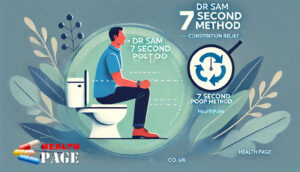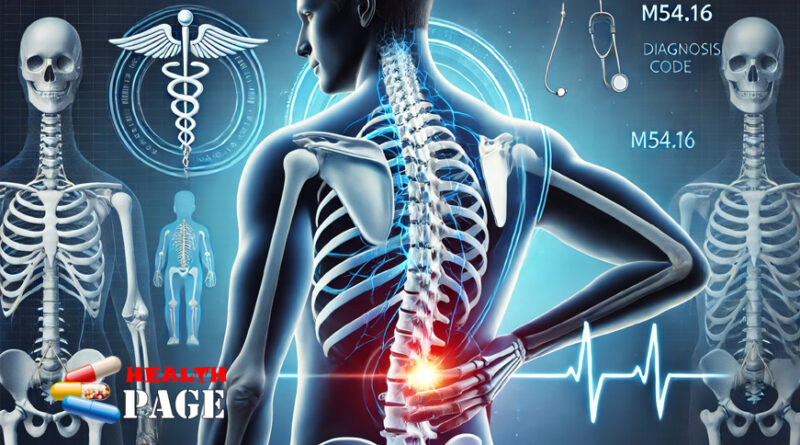M54.16 Diagnosis Code: Causes, Symptoms, and Treatment Options
Diagnosis codes play a crucial role in healthcare. They help doctors, insurance companies, and patients understand medical conditions. One such important code is the m54.16 diagnosis code.
The M54.16 diagnosis code refers to radiculopathy in the lumbar region. Radiculopathy is a condition where nerve roots in the lower back become compressed or irritated. This can cause pain, weakness, and numbness in the lower body.
Understanding the M54.16 diagnosis code is important for both patients and healthcare providers. It helps with accurate diagnosis, proper treatment, and insurance claims. Many people experience lower back pain, and this code provides a clear classification of a specific type of nerve-related pain.
In this article, we will explore the m54.16 diagnosis code in detail. We will discuss its causes, symptoms, and treatment options. Whether you are a patient seeking answers or a healthcare professional, this guide will provide valuable insights.
What is the m54.16 diagnosis code?
The m54.16 diagnosis code is used to classify lumbar radiculopathy, a condition affecting the nerves in the lower back. Radiculopathy occurs when nerve roots in the lumbar spine become compressed or inflamed, leading to pain, numbness, tingling, or weakness in the lower body.
Understanding Diagnosis Codes in Healthcare
Diagnosis codes, such as the m54.16 diagnosis code, are essential in the medical field. They help healthcare providers identify, document, and track specific medical conditions. These codes are part of the International Classification of Diseases (ICD-10) system, which ensures standardization in diagnosis and treatment worldwide.
Medical professionals use these codes for several purposes:
- Accurate Record-Keeping: Diagnosis codes help maintain clear and consistent patient records.
- Insurance Claims Processing: Insurance companies use them to approve treatments and reimburse medical expenses.
- Data Collection and Research: These codes help researchers analyze health trends and improve treatments.
Importance of Accurate Diagnosis
Correctly identifying a condition using the m54.16 diagnosis code is crucial for effective treatment. Misdiagnosis can lead to incorrect treatment plans, delaying recovery or worsening symptoms. A precise diagnosis allows doctors to develop targeted treatment strategies, such as physical therapy, medication, or surgery if necessary.
For patients, an accurate diagnosis ensures they receive the right care and insurance coverage. It also helps them understand their condition and explore the best treatment options.
In the next sections, we will explore the causes, symptoms, and treatment options associated with the M54.16 diagnosis code to help patients and healthcare providers make informed decisions.

Causes Related to the m54.16 diagnosis code
1. Understanding the Underlying Condition
The m54.16 diagnosis code refers to lumbar radiculopathy, a condition that affects the nerve roots in the lower back. This condition occurs when a nerve in the lumbar spine becomes compressed, inflamed, or irritated. It can cause pain, weakness, numbness, or tingling sensations in the lower back, buttocks, and legs.
Several medical conditions can lead to lumbar radiculopathy. These include:
- Herniated Discs: A slipped or bulging disc can press on spinal nerves.
- Degenerative Disc Disease: Age-related wear and tear can cause spinal discs to break down.
- Spinal Stenosis: Narrowing of the spinal canal can put pressure on nerves.
- Spondylolisthesis: A vertebra slipping out of place can compress nerves.
- Sciatica: Irritation of the sciatic nerve can cause symptoms similar to lumbar radiculopathy.
2. Common Causes
Several factors can contribute to lumbar radiculopathy, leading to the m54.16 diagnosis code. The most common causes include:
- Spinal Disc Problems: Herniated or degenerative discs can pinch nerve roots.
- Injuries: Trauma from accidents or falls can damage the spine.
- Poor Posture: Sitting for long periods or improper lifting techniques can strain the lower back.
- Obesity: Excess weight puts added pressure on the spine.
- Aging: Natural wear and tear increase the risk of disc degeneration.
- Repetitive Movements: Jobs or activities that require bending, twisting, or heavy lifting can cause nerve compression.
3. Risk Factors
Certain people are at a higher risk of developing lumbar radiculopathy, classified under the m54.16 diagnosis code. Key risk factors include:
- Age: People over 40 are more prone to spinal degeneration.
- Occupation: Jobs involving heavy lifting, bending, or prolonged sitting increase the risk.
- Physical Activity: Athletes and individuals with physically demanding routines are more susceptible.
- Genetics: A family history of spinal conditions can increase the likelihood of developing radiculopathy.
- Chronic Conditions: Diabetes and arthritis can contribute to nerve damage and inflammation.
Understanding these causes and risk factors helps in early prevention and effective treatment of lumbar radiculopathy. The next section will cover the symptoms linked to the M54.16 diagnosis code.
Symptoms of the Condition Identified by m54.16 diagnosis code
1. Primary Symptoms
The M54.16 diagnosis code refers to lumbar radiculopathy, which primarily affects the lower back and legs. The most common symptoms include:
- Lower Back Pain: A sharp or burning pain in the lower back, often radiating to the legs.
- Leg Pain (Sciatica-like Symptoms): Pain extending down one or both legs, commonly following the path of the affected nerve.
- Numbness or Tingling: A pins-and-needles sensation in the lower back, buttocks, or legs.
- Muscle Weakness: Difficulty standing, walking, or lifting objects due to weakened leg muscles.
These symptoms can limit mobility and make daily activities, such as walking, bending, or sitting for long periods, challenging. In severe cases, they may affect work performance and overall quality of life.
2. Secondary Symptoms
In addition to primary symptoms, some people may experience secondary symptoms, including:
- Loss of Reflexes: Reduced response in the knees or ankles.
- Difficulty Standing or Sitting: Pain may worsen in certain positions.
- Loss of Bladder or Bowel Control: A rare but serious symptom requiring immediate medical attention.
Recognizing symptoms early can prevent further complications. Ignoring mild pain or numbness may lead to chronic nerve damage or permanent weakness.
3. When to Seek Medical Help
It is essential to seek medical help if:
- Pain is persistent and does not improve with rest or medication.
- Weakness or numbness worsens in the legs.
- Daily activities become difficult due to pain or mobility issues.
- Severe symptoms, such as loss of bladder control, appear.
A timely diagnosis of the M54.16 diagnosis code allows doctors to provide effective treatment, preventing long-term complications. Early intervention, such as physical therapy, medications, or lifestyle changes, can significantly improve outcomes.
In the next section, we will explore the best treatment options for managing lumbar radiculopathy.
How is the M54.16 Diagnosis Code Used in Healthcare?
Role of Diagnosis Codes in Healthcare
Diagnosis codes are essential in healthcare for classifying medical conditions and ensuring standardized treatment. The M54.16 diagnosis code is part of the ICD-10 coding system, which helps healthcare providers identify lumbar radiculopathy and provide the correct treatment. These codes assist in medical documentation, billing, and research, ensuring patients receive appropriate care.
How Healthcare Providers Use the M54.16 Diagnosis Code
Doctors, physical therapists, and specialists use the M54.16 diagnosis code in various ways, including:
- Diagnosing the Condition: It helps doctors confirm lumbar radiculopathy based on patient symptoms and test results.
- Developing Treatment Plans: Providers use this code to create personalized treatment strategies, including medications, physical therapy, or surgical options.
- Referring to Specialists: The code helps primary care doctors refer patients to neurologists, orthopedic specialists, or pain management experts.
- Tracking Patient Progress: It allows healthcare professionals to monitor a patient’s response to treatment over time.
Importance of Proper Coding for Insurance and Medical Records
Accurate use of the M54.16 diagnosis code is crucial for:
- Insurance Claims: Insurance companies require correct coding to approve treatments and reimburse expenses.
- Medical Records: A well-documented diagnosis helps in future healthcare decisions and continuity of care.
- Legal and Compliance Purposes: Proper coding ensures compliance with healthcare regulations and prevents billing errors.
By understanding how the M54.16 diagnosis code is used in healthcare, patients and providers can ensure accurate diagnosis, effective treatment, and smooth insurance processing. In the next section, we will explore treatment options for managing lumbar radiculopathy.

Treatment Options for Conditions Related to M54.16 Diagnosis Code
1. Conservative Treatment Methods
For most patients with lumbar radiculopathy classified under the M54.16 diagnosis code, non-invasive treatments are the first line of care. These include:
- Medications: Pain relievers, anti-inflammatory drugs, and muscle relaxants help reduce pain and swelling.
- Physical Therapy: Stretching and strengthening exercises improve mobility and support spinal health.
- Heat and Cold Therapy: Applying heat or ice packs can reduce pain and inflammation.
- Chiropractic Care: Spinal adjustments may help relieve pressure on affected nerves.
- Epidural Steroid Injections: Cortisone injections provide temporary relief from severe pain.
Regular monitoring and follow-ups are crucial to track progress and adjust treatment if needed. If symptoms persist, more advanced treatments may be necessary.
2. Surgical Interventions
Surgery is considered only when conservative treatments fail or if symptoms become severe. Common surgical procedures include:
- Discectomy: Removal of a herniated disc pressing on the nerve.
- Laminectomy: Removal of part of the vertebra to relieve pressure.
- Spinal Fusion: Fusing vertebrae together to stabilize the spine.
These procedures help relieve nerve compression, but recovery requires proper rehabilitation and lifestyle changes.
3. Lifestyle and Preventative Measures
Preventing lumbar radiculopathy recurrence is essential for long-term health. Key preventive measures include:
- Regular Exercise: Strengthening core and back muscles supports spinal health.
- Healthy Diet: Proper nutrition reduces inflammation and promotes healing.
- Proper Posture: Maintaining good posture reduces spinal strain.
- Avoiding Heavy Lifting: Using correct lifting techniques prevents injuries.
By following these steps, patients can manage symptoms, prevent future issues, and improve overall spinal health.
Frequently Asked Questions (FAQs)
What does the M54.16 diagnosis code represent?
The M54.16 diagnosis code refers to lumbar radiculopathy, a condition where nerve roots in the lower back become compressed or irritated. This can cause pain, numbness, tingling, or weakness in the lower back, buttocks, and legs. It is a specific classification under the ICD-10 coding system used for medical diagnosis and treatment planning.
Is this condition treatable?
Yes, lumbar radiculopathy is treatable. Most cases improve with non-invasive treatments, such as medications, physical therapy, and lifestyle changes. In severe cases where conservative treatments do not provide relief, surgical options like discectomy or laminectomy may be necessary. Early diagnosis and proper treatment can help prevent long-term complications.
How long does recovery typically take?
Recovery time varies depending on the severity of the condition and the chosen treatment. Mild cases may improve within a few weeks to a few months with rest and physical therapy. If surgery is required, recovery may take several months, including rehabilitation. Regular exercise, good posture, and a healthy lifestyle can help speed up recovery and prevent recurrence.
Conclusion
Understanding the M54.16 diagnosis code is essential for both patients and healthcare providers. This code helps identify lumbar radiculopathy, a condition that affects the lower back and can lead to pain, numbness, and weakness in the legs. Accurate diagnosis ensures the right treatment, improving recovery and overall well-being.
If you are experiencing persistent lower back pain, tingling, or muscle weakness, it is important to consult a healthcare professional. Early diagnosis and proper treatment can prevent complications and enhance quality of life.
A precise diagnosis is the foundation of effective treatment. Whether through medications, physical therapy, or surgical options, managing lumbar radiculopathy properly can lead to better long-term health outcomes. Stay informed, seek medical advice when needed, and take proactive steps toward a pain-free life.



Pingback: Can You Overdose on Melatonin Gummies? A Guide to Safe Usage